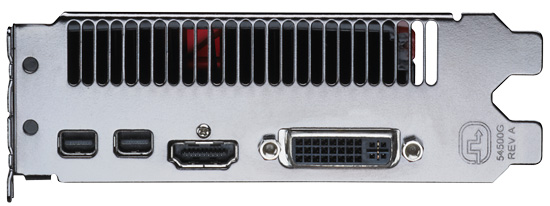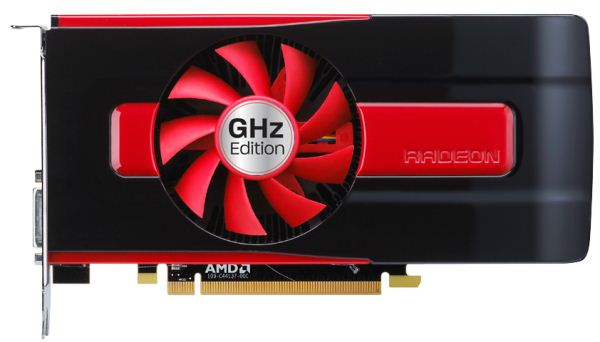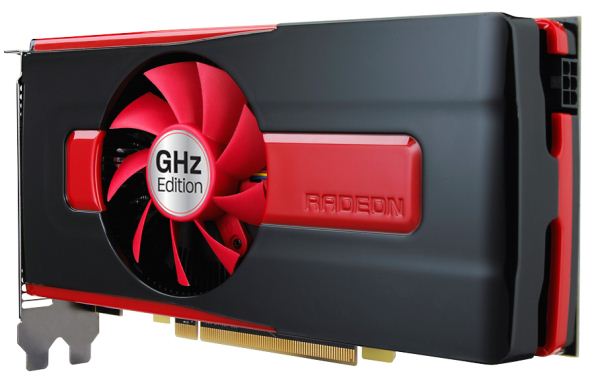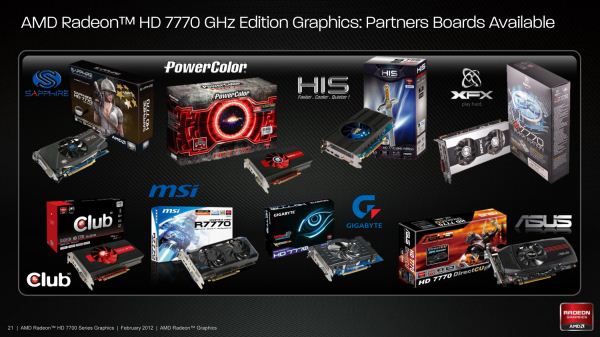AMD Radeon HD 7750 & Radeon HD 7770 GHz Edition Review: Evading The Price/Performance Curve
by Ryan Smith & Ganesh T S on February 15, 2012 12:01 AM EST- Posted in
- GPUs
- AMD
- HTPC
- GCN
- Radeon HD 7000
Meet the Radeon HD 7770 GHz Edition
The second card launching today is the Radeon HD 7770 GHz Edition. Compared to the 7750 it’s based on a fully enabled Cape Verde GPU and features a higher core clock of 1GHz, versus 800MHz on the 7750.
Starting as always with the cooler, for the reference 7770 AMD has gone with something that is best described as half of a blower. The shroud is completely enclosed on the sides, but due to the position of the fan the card exhausts hot air out of both the front and the rear of the card, which is something that’s common for dual-GPU cards such as the 6990 but atypical for a midrange video card. Heat transfer is provided by a basic black aluminum heatsink, while the fan is embedded in the middle of the heatsink.
As for the card itself, it’s effectively an extended version of the 7750. Like the 7750 the card is equipped with 4 256MB 5GHz Hynix GDDR5 RAM chips, along with some additional VRM circuitry to handle the higher 100W power limit for this board. External power is provided by a single 6pin PCIe power socket, while at the top of the card there is a single CrossFire connector. This is actually down from 2 connectors on the 5700 series, which comes as no great surprise as virtually no one ever used tri-CF with the 5700 series in the first place. Overall the card is 8.25” long with no notable shroud overhang, making it the same length as the 5770’s PCB.
Meanwhile for display connectivity AMD is using the same configuration as we’ve seen on the 7900 series: 1 DL-DVI port, 1 HDMI port, and 2 miniDP ports. Unlike the 7900 series AMD’s not requiring their partners to include any adaptors, so buyers with 2 DVI monitors will almost always be on their own. The presence of 2 miniDP ports means that the 7770 has quite a bit of flexibility in driving various displays, however as with the 7900 series if you want to drive more than 4 displays you will need a MST hub, the release of which is still some time off.

As for partner cards, as with the 7750 all of AMD’s partners are doing their own thing. No one will be using AMD’s reference cooler, though PowerColor in particular will be using a cooler similar to it. Everyone else will be using their own double-wide coolers, most of which will be open air as we typically see in this market segment. Like the 7900 series AMD is relying on the 7770 having some degree of overclockability, so there will be a number of factory overclocked cards taking advantage of this.
Finally, I wanted to quickly touch on the naming of the 7770. The official name of the 7770 is the Radeon HD 7770 GHz Edition; with the last bit being AMD’s latest marketing push. Starting with the 7770, AMD is going to be branding every card with a reference clock at or above 1GHz as a “GHz Edition” card to capitalize on the fact that they’ve hit 1GHz. Thus in spite of what the name implies there won’t be a 7770 non-GHz Edition card, as it’s a tagline rather than a true suffix necessary to differentiate cards.
With that said, while hitting 1GHz on a GPU is a notable accomplishment for AMD and should not be ignored, it’s not going to be particularly important in the grand scheme of things. The embarrassingly parallel nature of rendering means that GPU performance isn’t nearly as tied to clockspeeds as CPU performance is, as you can always lay down more functional units to improve performance. Clockspeeds do need to go up over time due to the limited parallelization of the command processor, but otherwise GPU performance has never been heavily dependent on clockspeeds.



















155 Comments
View All Comments
PatrickSteamboat - Wednesday, February 15, 2012 - link
Will there be any testing on Cape Verde's Crossfire scalability in the near future? I'm really interested to see if dual 7750s can fill the gap between it and the 6950. Unlocking a hidden, low power 6900 variant, the missing 6930, without having to match and compare more than three SKUs sounds too good to be true.Roland00Address - Wednesday, February 15, 2012 - link
7750s can't do crossfire since they do not have a crossfire bridge.7770s can do crossfire since they have a single crossfire bridge (can't do trifire though).
PatrickSteamboat - Thursday, February 16, 2012 - link
Can't believe I missed... anyways, thanks for that.
I found a preliminary benchmark with dual 7770s. Numbers look great so far, but at $318 for two, I'll be waiting until I can have both for less than $279. One now @MSRP, the second discounted once Kepler is out.
mczak - Thursday, February 16, 2012 - link
That isn't true. 7750 don't have a crossfire connector but they can do crossfire just fine, by transferring the data over the pcie bus.According to techpowerup benchmarks which tested that there's not even really a performance hit due to that (though they used a board with 2x16 pcie lanes, albeit only pcie 2.0, so should be similar to ivy bridge lga1155 which will have 2x8 pcie 3.0, and it might be worse on sandy bridge lga1155 which only has 2x8 pcie 2.0), though they say there were some stability issues, which certainly are driver fixable.
I usually question the viability of low-end CF setups however, I think you'd be far better off with one HD7800 card instead (you shouldn't need to wait that long for it after all).
Belard - Thursday, February 16, 2012 - link
Its been almost 4 years since the ATI 4850 was released. Within about 6~8 months of being on the market, it became a $100~110 card.The NEW 7750 is also a $100~110 and from looking at these reviews, it performs no better than a four year old gaming card that sold for $100.
Menoetios - Thursday, February 16, 2012 - link
Nvidia is as much to blame for the lack of shift in the price/performance curve as AMD. That's just the nature of competition. If you look at the 7770 and 7750 pricing compared to what Nvidia currently has available, it falls right in line. AMD doesn't care that you buy a 7770 or a 6850; with the former they'll make a nice margin, with the latter it'll help clear out the channel. They only care that you buy one of their products, and their products are priced just fine to that end. With only 123 mm2 die size (it's quite tiny), the 77** cards have a lot of room to get cheaper when Kepler is released. And I hope Kepler is REALLY good, because that's when we'll see the true price/performance shift.chizow - Thursday, February 16, 2012 - link
How so? Nvidia is not the one pricing their next-gen parts based on last-gen performance and pricing, AMD is. If Nvidia does that with Kepler, then you they share in equal blame. But AMD had the chance to fire the first salvo this generation and they whiffed, badly, on all 3 volleys now (7970, 7950 and now 7770).Menoetios - Thursday, February 16, 2012 - link
AMD have set their prices according to what's available on the market from Nvidia.chizow - Friday, February 17, 2012 - link
And that's exactly the problem! They're pricing new 28nm next-gen parts based on old 40nm last-gen price and performance levels. Nvidia's pricing was justified 14 months ago because the performance was there. It would not be satisfactory if they came out with a "new" part tomorrow and priced it the same as their old parts, would it?Blame lies squarely on AMD for this because they set the pricing on their parts and they were first to market. Look at it historically over the last 2-3 major generations, never once has Nvidia done this with a new architecture (not refresh) in terms of moving the performance bar so little while expecting the same top of the line premium pricing.
Hellbinder - Thursday, February 16, 2012 - link
Ok, Anand continues to amaze.. he/they are either dumber than a box of rocks or intentionally biased against AMD and simply looking for any excuse to skewer them. Personally i lean towards option number 1.The author of this review has completely buffooned the entire thing by getting the basic workings of AMD numbering & performance scaling WRONG.
yes the naming convention changed. but not in the way anand seems to think. This should be no brainier information for a site like this.
Top 7900 next 7800 next 7700 next 7500 next 7400 and so on.
The 6000 series was identical
Top 6800 next 6800 next 6700 next 6500 next 6400 and so on
the older models were different.
IF you want to compare apples to apples you compare the 6700 series to this series. The 6800 series is an entire tier above this card and should outperform it.
This site needs to get its crap together because nearly every other tech site makes this one look foolish, because they are foolish. or fire this reviewer and the editor and get some people who know what the hell they are talking about.